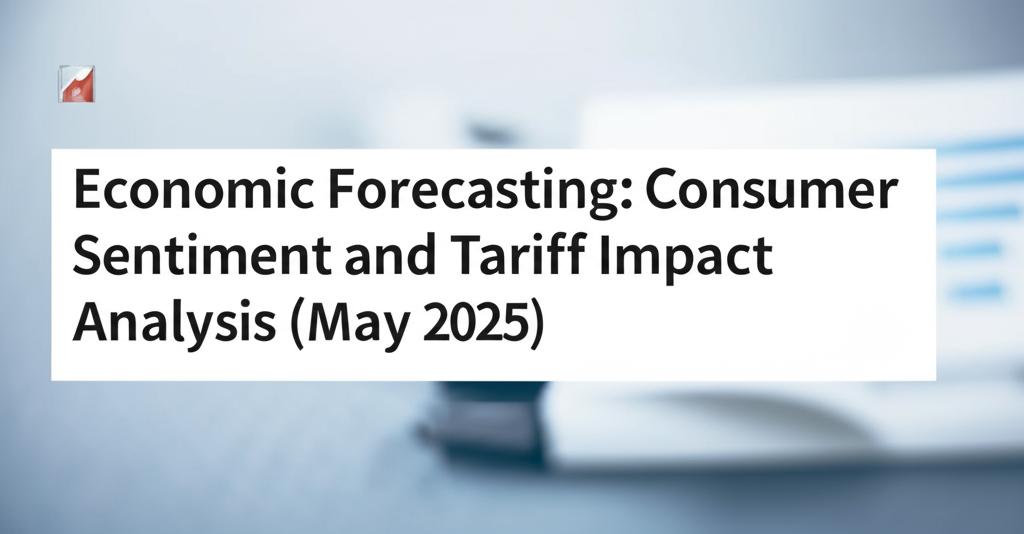The global economic landscape in May 2025 is characterized by a complex interplay of cautious consumer sentiment, the significant impact of new and escalating tariffs, and ongoing inflationary pressures. While some regions show resilience, a general slowdown in growth is anticipated, with heightened uncertainty impacting investment and spending decisions.
Consumer Sentiment: A Mixed Bag Amidst Economic PressuresConsumer confidence presents a varied picture across different economies. In the United States, consumer sentiment has seen a notable decline. The University of Michigan's Consumer Sentiment Index fell for the fourth consecutive month in April 2025, reaching its lowest level since July 2022. This drop is largely attributed to uncertainty surrounding trade policy and concerns about a potential resurgence of inflation. Consumers are perceiving risks to multiple aspects of the economy and are anticipating weaker income growth. This sentiment is echoed by data from GlobalData, which highlights that 56% of U.S. consumers are "extremely" or "quite concerned" about the impact of trade wars and import tariffs on product pricing. This anxiety is curbing discretionary spending and increasing price sensitivity.
In Europe, the European Commission's flash estimate for April 2025 also indicated a decrease in consumer confidence in both the EU and the euro area, moving further away from long-term averages. The Economic Sentiment Indicator (ESI) declined in both zones.
Australian consumer sentiment, as measured by the Westpac-Melbourne Institute, also saw a dip in April 2025, with concerns related to tariffs and a more uncertain outlook for interest rates playing a role. However, the federal budget appeared to have a slightly positive influence.
These trends suggest that households globally are becoming more cautious, which could translate to reduced consumer spending, a key driver of economic growth. Factors like persistent inflation, the rising cost of living, and job market anxieties are contributing to this cautious outlook.
Tariff Impact: A Significant Drag on Global Trade and GrowthThe implementation and escalation of tariffs, particularly by the United States, are a dominant factor shaping the economic outlook in May 2025. Sweeping U.S. tariff increases are upending global trade, with analyses projecting sharp contractions in trade volumes and significant welfare losses, especially for the U.S.
Multiple reports indicate a substantial increase in U.S. average effective tariff rates. For instance, some analyses show the U.S. average effective tariff rate (AETR) jumping from 2.2% in 2024 to a range of 7.1%-17.0% under 2025 scenarios, with peak rates potentially reaching levels unseen since the 1930s/40s. Specific tariffs on goods from China have escalated dramatically, with some reports indicating a potential baseline of 125-145% under a reciprocal regime, and even higher total rates when factoring in other existing tariffs.
The consequences of these tariffs are far-reaching:
- Reduced Global Trade: Global merchandise trade is expected to contract in 2025, a stark reversal from growth in 2024. Projections range from a -0.2% contraction with downside risk to -1.5%.
- Lower GDP Growth: Numerous institutions have revised down their GDP growth forecasts for 2025 due to tariffs.
The IMF downgraded its U.S. growth forecast for 2025 from 2.7% to 1.8% and projects a cumulative 0.8 percentage point reduction in global GDP growth for 2025-2026 due to tariffs.
Deloitte forecasts U.S. real GDP growth could slow to 1.5% in 2025 and 0.7% in 2026 in a scenario with significant tariffs.
J.P. Morgan Research revised down U.S. GDP growth to 1.6% for 2025 and sees a 40% risk of a global recession.
The Yale Budget Lab estimates U.S. real GDP growth will be 1.1 percentage points lower due to all 2025 tariffs.
- Inflationary Pressures: Tariffs are expected to contribute to higher inflation. The Yale Budget Lab estimates that all 2025 tariffs could lead to a 2.9% rise in the U.S. price level in the short run, equivalent to an average per-household loss of $4,700 in purchasing power (pre-substitution). Certain commodity prices, like apparel, are projected to see particularly sharp increases. The April 2025 CPI report is anticipated to show initial impacts, with larger inflation effects expected in the following months as the costs of intermediate goods feed through to consumer prices.
- Supply Chain Disruptions and Reconfiguration: Tariffs are forcing businesses to re-evaluate supply chains, potentially leading to shifts in production patterns and a less efficient, more opaque global trade system. Mexico has reportedly surpassed China as the top U.S. trading partner in early 2025.
- Impact on Businesses and Households: Businesses face increased costs and uncertainty, potentially leading to reduced investment. Households are expected to experience a loss in purchasing power and potentially job losses. Estimates suggest U.S. job impacts could range from 671,000 to 770,000 fewer jobs.
- Policy Responses: Central banks may be constrained in their ability to cut interest rates due to tariff-induced inflation. Some economies, like China and the Eurozone, may use fiscal stimulus to counter some of the negative impacts.
The global economy in May 2025 is navigating a period of significant adjustment. While a full-blown tariff-induced recession is not the baseline forecast for all analysts, the risks have clearly risen. Economic growth is generally expected to slow compared to previous years.
Uncertainty remains a key theme. The duration and final scope of tariff policies, potential retaliatory actions, and the effectiveness of mitigating strategies (like businesses leveraging AI to optimize logistics and reduce costs) will all play a crucial role in shaping the economic trajectory for the remainder of the year and beyond.
Businesses and consumers alike are adapting to this new environment. For consumers, this means being more price-conscious and potentially shifting spending patterns. For businesses, the focus is on building resilience, managing costs, and navigating complex trade dynamics. The evolving situation calls for careful monitoring of economic indicators and a flexible approach to strategic planning.

